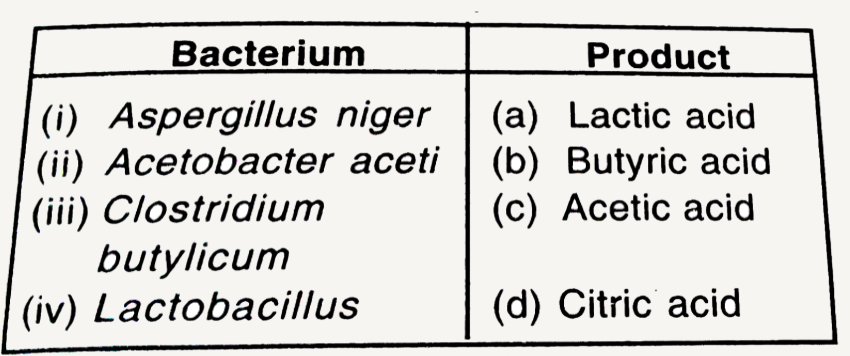Match the following list of bacteria and their commercially important products.
BacteriumProduct(i)Aspergillus niger(A)Lactic acid(ii)Acetobacter aceti(B)Butyric acid(iii)Clostridium butylicum(C)Acetic acid(iv)Lactobacillus(D)Citric acid
Choose the correct match.
i−(B),ii−(C),iii−(D),iv−(A)
i−(B),ii−(D),iii−(C),iv−(A)
i−(D),ii−(C),iii−(B),iv−(A)
i−(D),ii−(A),iii−(C),−iv−(B)
The correct Answer is:C
To solve the problem of matching the bacteria with their commercially important products, we will analyze each bacterium and its corresponding product step by step.
1. Identify Aspergillus niger:
- Aspergillus niger is a fungus, not a bacterium. It is primarily known for its role in the production of citric acid.
- Match: Aspergillus niger → (D) Citric acid.
2. Identify Acetobacter aceti:
- Acetobacter aceti is a bacterium that is known for converting ethanol into acetic acid through the process of oxidation.
- Match: Acetobacter aceti → (C) Acetic acid.
3. Identify Clostridium butylicum:
- Clostridium butylicum is a bacterium that is involved in the production of butyric acid through fermentation processes.
- Match: Clostridium butylicum → (B) Butyric acid.
4. Identify Lactobacillus:
- Lactobacillus is a group of bacteria that are known for their role in the production of lactic acid, especially in the fermentation of dairy products.
- Match: Lactobacillus → (A) Lactic acid.
Final Matching:
- (i) Aspergillus niger → (D) Citric acid
- (ii) Acetobacter aceti → (C) Acetic acid
- (iii) Clostridium butylicum → (B) Butyric acid
- (iv) Lactobacillus → (A) Lactic acid
Summary of Matches:
- (i) Aspergillus niger - (D) Citric acid
- (ii) Acetobacter aceti - (C) Acetic acid
- (iii) Clostridium butylicum - (B) Butyric acid
- (iv) Lactobacillus - (A) Lactic acid
- Aspergillus niger is a fungus, not a bacterium. It is primarily known for its role in the production of citric acid.
- Match: Aspergillus niger → (D) Citric acid.
- Acetobacter aceti is a bacterium that is known for converting ethanol into acetic acid through the process of oxidation.
- Match: Acetobacter aceti → (C) Acetic acid.
- Clostridium butylicum is a bacterium that is involved in the production of butyric acid through fermentation processes.
- Match: Clostridium butylicum → (B) Butyric acid.
- Lactobacillus is a group of bacteria that are known for their role in the production of lactic acid, especially in the fermentation of dairy products.
- Match: Lactobacillus → (A) Lactic acid.
- (i) Aspergillus niger → (D) Citric acid
- (ii) Acetobacter aceti → (C) Acetic acid
- (iii) Clostridium butylicum → (B) Butyric acid
- (iv) Lactobacillus → (A) Lactic acid
- (i) Aspergillus niger - (D) Citric acid
- (ii) Acetobacter aceti - (C) Acetic acid
- (iii) Clostridium butylicum - (B) Butyric acid
- (iv) Lactobacillus - (A) Lactic acid
Topper's Solved these Questions
- MICROBES IN HUMAN WELFAREBook:NCERT FINGERTPS ENGLISHChapter:MICROBES IN HUMAN WELFAREExercise:Assertion & Reaosn
Explore 15 Videos
- MICROBES IN HUMAN WELFAREBook:NCERT FINGERTPS ENGLISHChapter:MICROBES IN HUMAN WELFAREExercise:Microbes In Human Welfare
Explore 138 Videos
- MICROBES IN HUMAN WELFAREBook:NCERT FINGERTPS ENGLISHChapter:MICROBES IN HUMAN WELFAREExercise:HOTS
Explore 5 Videos
- HUMAN REPRODUCTIONBook:NCERT FINGERTPS ENGLISHChapter:HUMAN REPRODUCTIONExercise:Human Reproduction
Explore 185 Videos
- MOLECULAR BASIS OF INHERITANCEBook:NCERT FINGERTPS ENGLISHChapter:MOLECULAR BASIS OF INHERITANCEExercise:Molecular Basis Of Inheritance
Explore 151 Videos
Similar Questions
Match the following list of bacteria and their commercially important products
Choose the correct match

View SolutionMatch the following organisms with the products they produce: (a) Lactobacillus(i) Cheese(b) Saccharomyces cerevisiae(ii) Curd(c) Aspergillus niger(iii) Citric Acid(d) Acetobacter acetic(iv) Bread(v) Acetic Acid
View SolutionMatch column I with column II and select the correct option from the given codes
Column IColumn IIA.Aspergilius niger(i)EthanolB.Clostridium butylicm(ii)StatinsC.Saccharomyces cerevisiae(iii)Citric acidD.Trichoderma polysporum(iv)Butyric acidE.Monascus purpureus(v)Cyclosporin A
View SolutionMatch with reference to corpora adiposa of Periplaneta and find the correct option
III(a)Trophocytes(i)Contain symbiotic bacteria(b)Mycetocytes(ii)Store food(c)Oenocytes(iii)Store uric acid(d)Urate cells(iv)Synthesise and store lipids
View SolutionIdentify the blank spaces A,B,C and D in the following table and select the correct answer.
Type of microbeScientific nameCommercial productBacteriumAStreptokinaseBAspergillus nigerCitric acidFungusTrichonderma polysporumCBacteriumDButyric acid
View SolutionMatch column I with column II and select the correct answer from the gives codes.
ColumnIColumnIIA.Trichoderma(i)Free living nitrogen fixing bacteriaB.Streptomyces(ii)Biocontrol agentC.Azospirillum(iii)Lactic acidD.Lactobacillus(iv)Source of antibiotic
View SolutionMatch the animals given in column A with their location in column B.
Column AColumn B(i)DodoA.Africa(ii)QuaggaB.Russia(iii)ThylacineC.Mauritius(iv)Stellar's sea cowD.Australia
Choose the correct match from the following.
(a) i-A, ii-C, iii-B, iv-D
(b) i-D, ii-C, iii-A, iv-B
(c) i-C, ii-A, iii-B, iv-D
(d) i-C, ii-A, iii-D, iv-B
View SolutionMatch Column - I with Column - II and select the correct option using the codes given below :
Column-IColumn-IIa.Citric acid(i)Trichodermab.Cyclosporin A(ii)Clostridumc.Statins(iii)Aspergillusd.Butyric acid(iv)Monascus
View SolutionMatch the following and choose the correct combination from the option given
Columa IColumn II(Organic Compound)(Example)A. Fatty acid1. Glutamic acidB. Phospholipid2. TryptophanC. Aromatic amino acid3. LecithinD. Acidic amino4. Palmitic acid
View SolutionMatch the items of column I and column II
Column IColumn IIa Auxinp GA3b Gebberellinsq Indole Acetic Acidc Cytokininr Abscisic Acidd Dormins Acetic acidt Zeatin
View Solution

